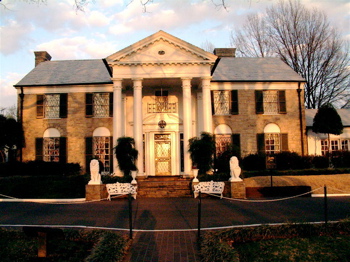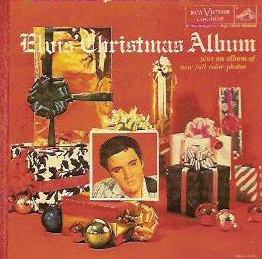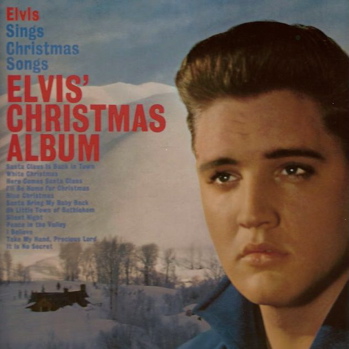
On August 27,1957. Elvis left Memphis for a quick concert tour of the Pacific Northwest and some recording work in Los Angeles. He returned to Graceland on September 11.
The next morning the Graceland gates were locked because gatekeeper Uncle Travis was in the hospital. While he was recovering, the house behind Graceland where he and his family lived was redecorated. Workers put up new wallpaper and refinished the floor.
A few days later, two Whitehaven Welcome Wagon ladies showed up at the Graceland gates to welcome the Presley family to the neighborhood. Mrs. Norma Provost and Mrs. Carol Godwin were pleasantly surprised when they were shown into the house. "What we saw of the Presley home was perfectly gorgeous," Mrs. Provost told the Press-Scimitar, "not gaudy as we had thought it would be from reading about the colors. The living room has red rug, blue walls and white draperies, and there's gold trim on practically everything. Elvis' music room is right off the living room, and it's mostly white."
The two women presented two big baskets of welcoming gifts to Gladys Presley. "We carried gifts from 15 merchants," explained Mrs. Provost. "Fourteen of them wanted to give something special. The other one said no, they should be treated like any other newcomers." The gifts included a gold planter, tea-aprons, a sheet and pillow case set, a set of tea towels, and a large ashtray.
While the two ladies were talking to Gladys, her son came in to see them. "It was 3 in the afternoon and he was wearing black satin pajamas," said Mrs. Provost. After presenting Elvis with a teddy bear as a welcoming gift, the women were told it was the 623rd teddy bear Elvis had received. Mrs. Provost told the newspaper that the Presleys were very appreciative of the special welcome they had received from the Welcome Wagoners.
A few days later, two Whitehaven Welcome Wagon ladies showed up at the Graceland gates to welcome the Presley family to the neighborhood. Mrs. Norma Provost and Mrs. Carol Godwin were pleasantly surprised when they were shown into the house. "What we saw of the Presley home was perfectly gorgeous," Mrs. Provost told the Press-Scimitar, "not gaudy as we had thought it would be from reading about the colors. The living room has red rug, blue walls and white draperies, and there's gold trim on practically everything. Elvis' music room is right off the living room, and it's mostly white."
The two women presented two big baskets of welcoming gifts to Gladys Presley. "We carried gifts from 15 merchants," explained Mrs. Provost. "Fourteen of them wanted to give something special. The other one said no, they should be treated like any other newcomers." The gifts included a gold planter, tea-aprons, a sheet and pillow case set, a set of tea towels, and a large ashtray.
While the two ladies were talking to Gladys, her son came in to see them. "It was 3 in the afternoon and he was wearing black satin pajamas," said Mrs. Provost. After presenting Elvis with a teddy bear as a welcoming gift, the women were told it was the 623rd teddy bear Elvis had received. Mrs. Provost told the newspaper that the Presleys were very appreciative of the special welcome they had received from the Welcome Wagoners.









 Before looking at how critics reacted to "Elvis' Christmas Album" in 1957, let's take a quick look at the LP's content. Four of the album's 12 cuts were recycled recordings of non-Christmas religious hymns that Elvis had recorded in January 1957 and released on an extended play album in April of that year. They were "Peace in the Valley," "I Believe," "Take My Hand, Precious Lord," and "It Is No Secret (What God Can Do)." Elvis used traditional arrangements on all four songs, and so, beyond the quality of his voice, critics found little to disparage in those recordings when they were included in Presley's holiday album.
Before looking at how critics reacted to "Elvis' Christmas Album" in 1957, let's take a quick look at the LP's content. Four of the album's 12 cuts were recycled recordings of non-Christmas religious hymns that Elvis had recorded in January 1957 and released on an extended play album in April of that year. They were "Peace in the Valley," "I Believe," "Take My Hand, Precious Lord," and "It Is No Secret (What God Can Do)." Elvis used traditional arrangements on all four songs, and so, beyond the quality of his voice, critics found little to disparage in those recordings when they were included in Presley's holiday album.  Radio station CKXL in Calgary also banned Elvis's album. "Presley's latest release has, we feel, no place on our station," said a CKXL spokesman. "We have the album for audition—it speaks for itself. Presley sings the Christmas songs exactly as we expected he would. It is one of the most degrading things we have heard in some time." He described Presley as "panting" through the hymns "Silent Night" and "O Little Town of Bethlehem." Another Calgary station, CFCN, denied an official ban, but stated Elvis's album "would not be played because it happens to be in lousy taste."
Radio station CKXL in Calgary also banned Elvis's album. "Presley's latest release has, we feel, no place on our station," said a CKXL spokesman. "We have the album for audition—it speaks for itself. Presley sings the Christmas songs exactly as we expected he would. It is one of the most degrading things we have heard in some time." He described Presley as "panting" through the hymns "Silent Night" and "O Little Town of Bethlehem." Another Calgary station, CFCN, denied an official ban, but stated Elvis's album "would not be played because it happens to be in lousy taste." 




































